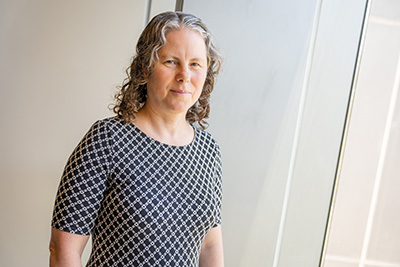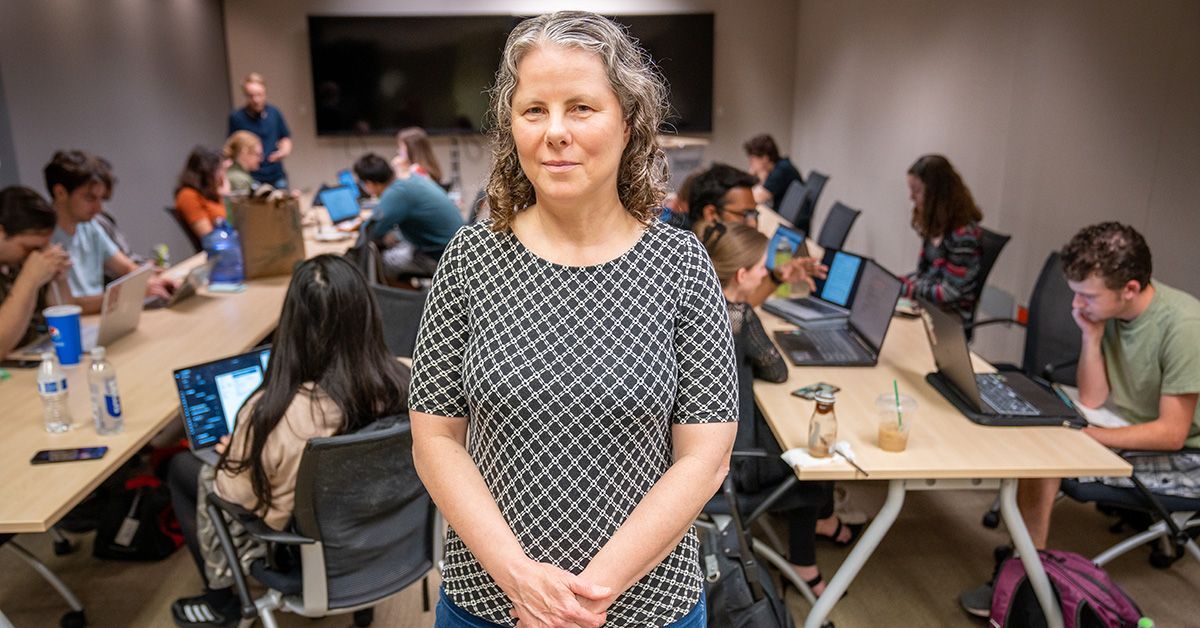Pamela Cosman Bridges Disciplines to Build a More Efficient, Equitable Future
Story by:
Published Date
Article Content
Pamela Cosman drives hard—she’s the recipient of multiple research and diversity awards, a published author, a tenured faculty member with the UC San Diego Jacobs School of Engineering, a mother of four and director of the NeuroDiversity in Tech internship program at the university’s Qualcomm Institute (QI).
She has won multiple awards for her research in image and video compression, and for promoting mentorship and gender equity in her field.
At times, however, it has been hard for Cosman to choose a path when her interests pulled her in different directions.
Many Crossings
Cosman grew up in Los Angeles, California, with her mother, an artist; her father, an electrical engineer; and three older brothers. As a child, she played with toy construction sets alongside her siblings and learned mathematics from her father, leaping years ahead of her peers.
This last experience would provide something of an unexpected lifeline when Cosman was in the seventh grade. Her parents opted to challenge her with a language immersion school—all instruction was in French, and Cosman spoke only English. She had to learn a new language while trying to keep pace with her classmates, all of whom spoke French at home. Cosman began to fall behind in all subjects except math, the one place where the language barrier evaporated and she felt comfortable.
“It was very clear to me from that point that I liked STEM,” said Cosman, referring to the acronym for science, technology, engineering and mathematics. “At the same time, I was pulled in other directions.”
Cosman also liked medicine and creative writing. That same year, at age 12, she wrote a children’s book and enthusiastically sent it to more than a dozen publishers, all of whom rejected it.
Years later, as she prepared to enter college, Cosman revisited her plans for the future. She enrolled at the California Institute of Technology (Caltech) in 1983 and declared a double-major in electrical engineering and physics, on top of plans to complete all the prerequisites for medical school.
“That was my attempt to narrow it down,” she said.
By the time she reached her junior year, however, she realized hitting all of her goals within a four-year timeframe was beyond her best efforts. Not without regret, she dropped her physics degree. She graduated in 1987 with her bachelor’s in electrical engineering and the complete suite of prerequisites for medical school.
More Choices
Cosman was accepted to both Stanford University’s electrical engineering Ph.D. program and its medical school. She chose the former, primarily because she’d received a graduate fellowship from the National Science Foundation to fund her studies. By the end of her second year, however, she found herself struggling.
“My advisor completely ignored me for two years,” said Cosman. “At the time, I just thought that’s what a Ph.D. was. I thought, ‘Everybody is going through this and I’m just not smart enough to hack it.’”
Determined to turn things around, Cosman approached Stanford Medicine and asked if her admission might be reactivated. The staff informed her that her MCAT scores were one month beyond the three-year limit. She would have to relearn the material and retake the test.

Cosman decided to switch advisors instead. She signed on with Robert Gray, a faculty member in Stanford University’s Department of Electrical Engineering, to study image compression in the medical field.
Then and now, digital image compression has become part of daily life. In our day-to-day routines, its applications range from barcode scanners to safety measures in autonomous vehicles.
In Gray’s lab, Cosman was part of a team investigating whether digitizing and compressing medical images, like X-rays, could make it easier to store and share data. By enabling the transmission and remote interpretation of scans, could this new approach improve the diagnosis of diseases like breast cancer, for example? Or would the data lost through image compression mean that doctors were more likely to miss cancer’s warning signs?
For the next five years, through her Ph.D. and into her position as a visiting lecturer with the University of Minnesota, Cosman worked with Gray to determine the exact formula for compressing an image and retaining as much of its useful information as possible. Cosman describes Gray as “very involved” and dedicated to his students. The experience—so different from the first two years of her Ph.D. work —shaped the future of Cosman’s research and professional career.
“The difference in advisors was one of the main things that made me want to become a professor,” said Cosman. “I thought I could do that job well.”
Building a Framework for Equity
In July 1995, Cosman returned to the West Coast for a professorship with UC San Diego’s Department of Electrical and Computer Engineering. She applied her research to image and video compression and signal processing, including applications in the biological sciences.
In 2006, Cosman’s work propelled her to a position as director of the Jacobs School’s Center for Wireless Communications. By July 2011, she was the department’s vice chair. Two years later, she was both the Jacobs School’s associate dean for students and its faculty equity advisor.
A year into her appointment as faculty equity advisor, Cosman attended an event that would highlight a need for greater resources for women in her field.
As a regular part of the hiring process, her department asked candidates to deliver an hour-long presentation of their research. One such seminar was what Cosman calls “grueling.” The female candidate fielded so many interruptions that she could barely conclude her talk. A fellow faculty member approached Cosman afterward to commiserate.
“We were both fuming,” Cosman said.
Cosman’s colleague suggested that female candidates were being asked more questions than their male counterparts. Certain that the issue had been studied, Cosman approached UC San Diego sociologist Mary Blair-Loy, who connected her with a colleague. This researcher confirmed that it was well documented that women were questioned more often than men, but said the issue had never been studied within the context of faculty job interview presentations.
Cosman, Blair-Loy and Laura Rogers, also of UC San Diego’s Department of Sociology, partnered with colleagues to take on the study themselves. With the help of students, the researchers analyzed video recordings of 119 such “job talks” from top faculty candidates across two academic years and five engineering departments at two research-focused universities.
Students carefully noted the candidates’ gender, the number of audience interruptions and follow-up questions, and the total number of questions received. Researchers also tracked whether audience members raised their hands, interrupted the speaker, or asked follow-up questions based on a previous question.
Their study, published in the journal Social Sciences, showed that women were asked more questions, even after accounting for years of research experience. They particularly received more follow-up questions, where one question prompted another back-to-back. In several cases, candidates of either gender were asked up to 50 questions during a 60-minute talk.
Taking It Forward
Cosman and her co-authors began to advocate for a facilitator who might intervene if audience questions prevented the candidate from successfully sharing their work. In 2015, the researchers received funding from a Frontiers of Innovation grant to establish the UC San Diego Center for Research on Gender in STEMM (adding medicine to the familiar acronym).
In 2017, Cosman won a Pinnacle Award from San Diego-based organization Athena in recognition for her role as a leader and mentor for other women in STEM.
Cosman’s work in diversity and equity didn’t stop there. She went on to develop unconscious bias training to promote a more fair and inclusive hiring environment within her department. During her tenure as faculty equity advisor, the UC San Diego Jacobs School of Engineering recruited 13 women and two men from underrepresented demographics to its faculty body.
Cosman has also led a $500,000 grant from the State of California to advance faculty diversity, and twice attended the national convention of the Electrical and Computer Engineering Department Heads Association to speak on her and her fellow researchers’ findings on unconscious gender bias. As the Jacobs School of Engineering’s associate dean for students, she established programs and initiatives to diversify the student body and provide expanded mentoring opportunities.
Cosman also stresses the importance of reaching female audiences early, when they might begin to face cultural messaging that frames STEM as a domain for boys. She leveraged her passion for creative writing through two children’s books, “The Secret Code Menace” and “The Hexagon Clue,” released by Ransom Publishing Ltd. in 2015 and 2021, for middle-grade audiences. The books follow three children who use encoded messages and other elements of engineering to bust a bank robbery and solve a series of thefts.
In 2020, Cosman published “Free to Choose STEM: Data and Reflections on Girls and STEM Careers” through the Institute of Electrical and Electronics Engineers (IEEE). The book shares her experiences as a female researcher in STEM, and study findings on gender in her field.

Cosman’s advocacy has taken root at home, too. As a mother to an autistic son, she’s seen firsthand a lack of resources preparing autistic adults for the workforce.
In 2019, Cosman and colleague Leanne Chukoskie, now a researcher at Northeastern University, co-wrote a grant to fund a UC San Diego-based neurodiversity program for young adults on the autism spectrum. The NeuroDiversity in Tech summer internship, now part of QI’s Workforce Development Program, provides a paid opportunity for about 15 individuals from across the country to travel to UC San Diego, form teams and work with clients to develop educational video games. Interns gain the skills to lay the foundation for careers in technology, with both on-site and remote professional development lectures and workshops from coaches as well as guest speakers from major companies like Ubisoft.
Today, Cosman directs the program, offering interns guidance and direction as the initiative moves into its fifth year.
Learning from Students
Still, Cosman continues to embrace the field of electrical engineering. Engineering was her doorway to the NeuroDiversity in Tech internship, where she first designed mock job interviews in virtual reality for interns.
Through her positions with the UC San Diego Jacobs School of Engineering and Qualcomm Institute, Cosman has found the freedom to make the same cross-disciplinary connections she has always enjoyed. As a Ph.D. advisor, she has mentored students who have pushed how she thought of her research’s applications. Her work has expanded to include enhancing underwater images and circled back to her initial interest in medical science and imaging.
“It’s inspiring being in a place where people are open to starting new projects,” said Cosman. “UC San Diego has always been great for collaborations. The level of support one gets here to branch out is really nice.”
Share This:
You May Also Like
Stay in the Know
Keep up with all the latest from UC San Diego. Subscribe to the newsletter today.




